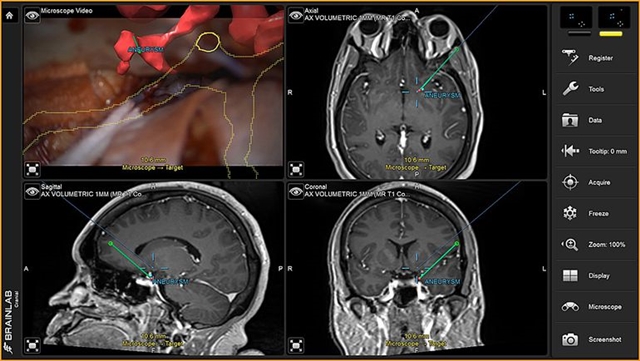4 August 2016. Neurosurgeons at Mount Sinai Medical Center in New York used virtual reality technology for the first time in a delicate procedure on a patient’s brain. The team led by Joshua Bederson, system chair of Mount Sinai’s neurosurgery department, employed the Captiview system made by Leica Microsystems.
The Captiview system provides a way of integrating image data from multiple sources into the microscopes used by surgeons in sensitive or difficult procedures in the brain and elsewhere. Digitized magnetic resonance imaging, computed tomography, and angiogram images can be overlaid on the real-time view focused on the surgical target as seen by a surgeon through a microscope. Previously, surgeons would view these images on separate displays.
The Captiview system is built in as a module for Leica’s M530 model surgical microscopes. The system provides 2-D and 3-D images as well as video, visible through the eyepiece. The surgeon can switch between live or overlaid image views, as well as between live and preoperative images. The system includes markers for positional tracking and auto-focus, and is controlled with cranial navigation software by BrainLab.
Bederson and colleagues first used Captiview in surgery to treat an aneurysm, a bulge in a blood vessel in the brain. Aneurysms run the risk of rupturing, leaking blood into the brain and causing a stroke, which occurs most often in the space between the brain and thin tissues covering the brain. The Brain Aneurysm Foundation says about 6 million, or 1 in 50, people in the U.S. experience an unruptured brain aneurysm, with 30,000 individuals suffering a rupture. About 40 percent of brain aneurysms are fatal, with about 2 in 3 survivors (66%) experiencing permanent neurological damage.
“This next-generation augmented virtual reality tool provides real-time information in ways never before realized,” says Bederson in a Mount Sinai statement. Bederson worked with Leica and BrainLab in developing the system.
Mount Sinai expects to integrate the Captiview system into its current surgical technology made by Surgical Theater that provides 3-D visualization. The medical center says Bederson owns shares in Surgical Theater. Bederson tells more about Captiview in the following video.
- Nanotech Imaging Start-Up Raises $3M in Seed Financing
- Technique Devised for 3-D Alzheimer’s Brain Images
- Wearable System Devised for Stroke Rehab at Home
- Autonomous Robot Shown Better at Soft-Tissue Surgery
- Phones, Wearables Studied to Monitor Brain Disorders
* * *


 RSS - Posts
RSS - Posts
You must be logged in to post a comment.